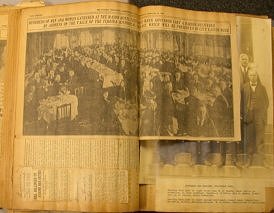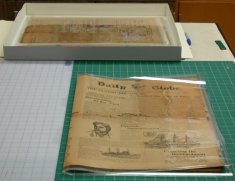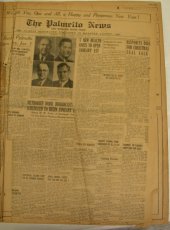Newspapers are an extremely valuable source of information about the world around us. The give us international, national and local news, sports, and weather information. They announce important occurrences, contain feature stories, human interest items, marriage announcements and many other things that are tempting to clip and save. However, newspapers are some of the most difficult of documents to preserve. They are printed on very low quality wood pulp paper that is extremely high in acid content and use poor quality inks. They are printed on a daily or weekly basis and are not meant to last forever.
The best solution is to photocopy the article in question onto permanent paper. Permanent paper is acid free, lignin free, and tear resistant. It meets ANSI standards for paper permanence and can be purchased at the local office supply store. This will ensure the text of the article will endure, even after the original item turns brown and brittle. However, photocopying the entire front page is not an easy matter.
|
There are a few things that can be done to prolong the life of newspapers or clippings.
Environment
Temperature and humidity have a great effect on paper. High temperatures will speed up the reaction of the acids inherent in the paper. Warm, moist air can cause mold spores to sprout on paper. Changes in temperature and humidity will cause paper to expand and contract, which can curl and split the paper.
The best storage climate for paper is 65º and 40-55% humidity. This might be hard to attain in our Florida climate, so having the temperature and humidity in the storage area as cool and dry as possible is a good compromise. A general rule of thumb is, "If you are hot and sticky, your paper is, too." Stability in the temperature and humidity levels is also important. Stable temperature and humidity, even if they are a little higher than the recommendations, are much better than temperature and humidity levels which fluctuate from cool and dry to hot and moist and back again.
Light also damages paper. It can cause inks to fade, especially colored inks, and can accelerate the browning of the paper. Store your clippings in the dark. The best way to do this is by putting them into acid free boxes.
Pollution and dust also damage paper. Car exhaust is contains sulfur dioxide which, when mixed with water, turns into sulfuric acid. Sulfuric acid can be damaging to paper products, especially those that are already acidic in nature. It is helpful to filter the air in your storage area with a high efficiency filter such as a HEPA filter. HEPA filters can pull pollution, mold, and dust particles from the air and add to a room's air circulation. Air circulation also helps to cool the environment and keep the humidity low. HEPA filters are available at local hardware and department stores.
Storage
Black and white newsprint can be deacidified with an alcohol based deacidification spray. Deacidification spray is available at art or scrapbooking stores or on the Internet from library and archival supply vendors (a list of vendors is available at Conservation OnLine at http://palimpsest.stanford.edu/bytopic/suppliers/.
Deacidification spray applies a buffer to the item it coats, but it is not permanent. The acids in newsprint will eat through the buffer in time, and the paper will again become acidic. One application will last from 7-10 years and can be reapplied after that time.
Deacidification sprays will affect colored inks and papers, so they might not be the best answer for the Sunday comics page. They also are not healthy for your lungs, so use plenty of ventilation when applying them.
Newspaper clippings should not be glued into scrapbooks. Use polyester photograph sleeves or encapsulation envelopes to hold newspaper clippings, then place them into a binder for "scrapbooking" your newspapers. For more information on making your own encapsulations or polyester sleeves, see Encapsulation.
 |
Newspaper clippings glued into a scrapbook. The large format of most articles does not lend itself well to this. |
The best storage solution for newspapers is to box them in acid free, buffered boxes. The boxes come in all sizes, including some that will fit full sized newspapers. The boxes can be purchased from library and archive supply stores.
Store full sized newspapers flat. They can be interleaved with acid free, buffered tissue, also available from library and archive supply stores. Clippings can be stored upright in acid free folders or envelopes and boxes.
Another option for newspaper storage is to encapsulate the clippings and store them in acid free boxes. Full sized newspapers may also be encapsulated.
 |
|
More information on storage materials can be found in "Buzzwords in the Archival Industry." See also "Protect your Historic Scrapbooks," or "Making Archival Scrapbooks."




